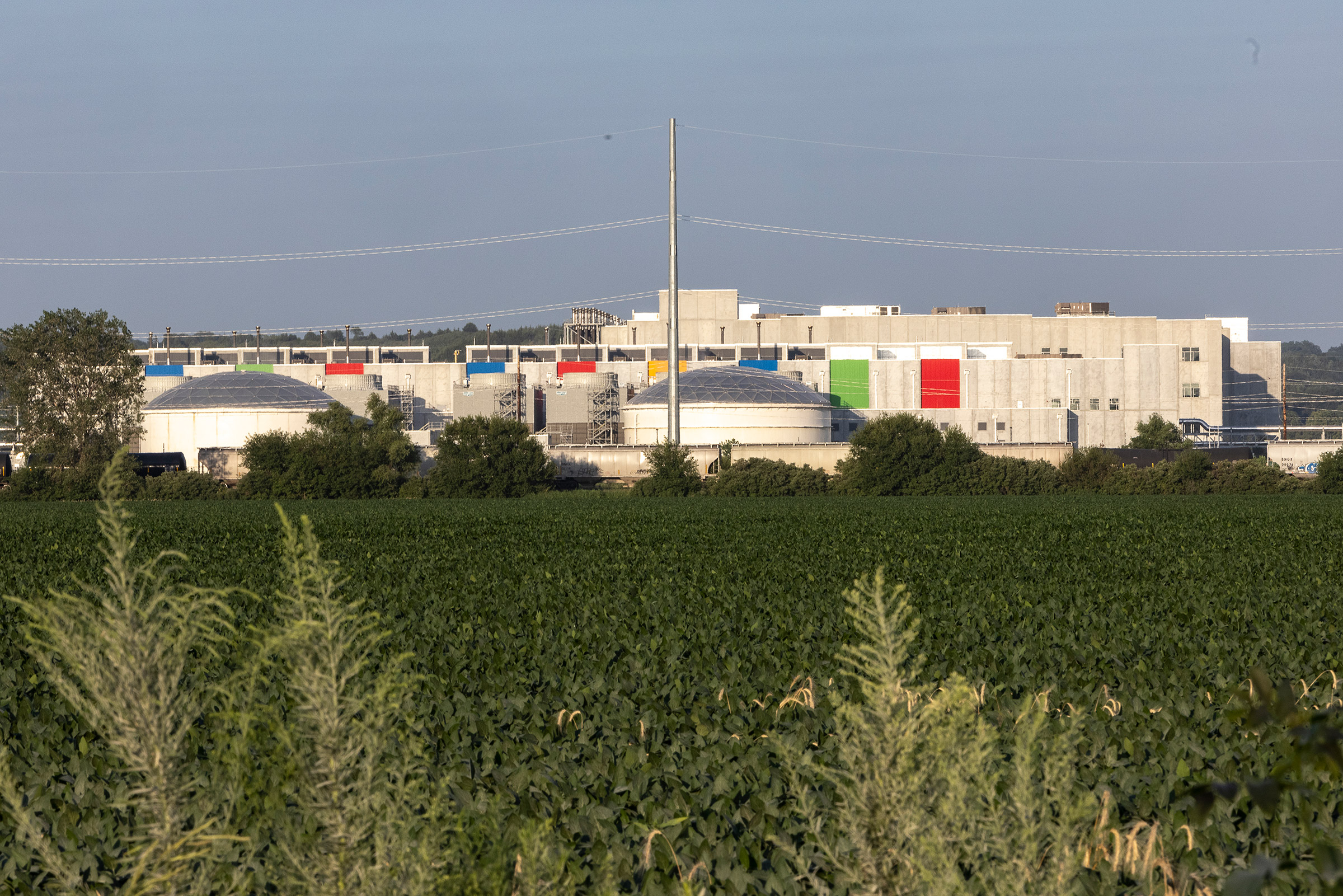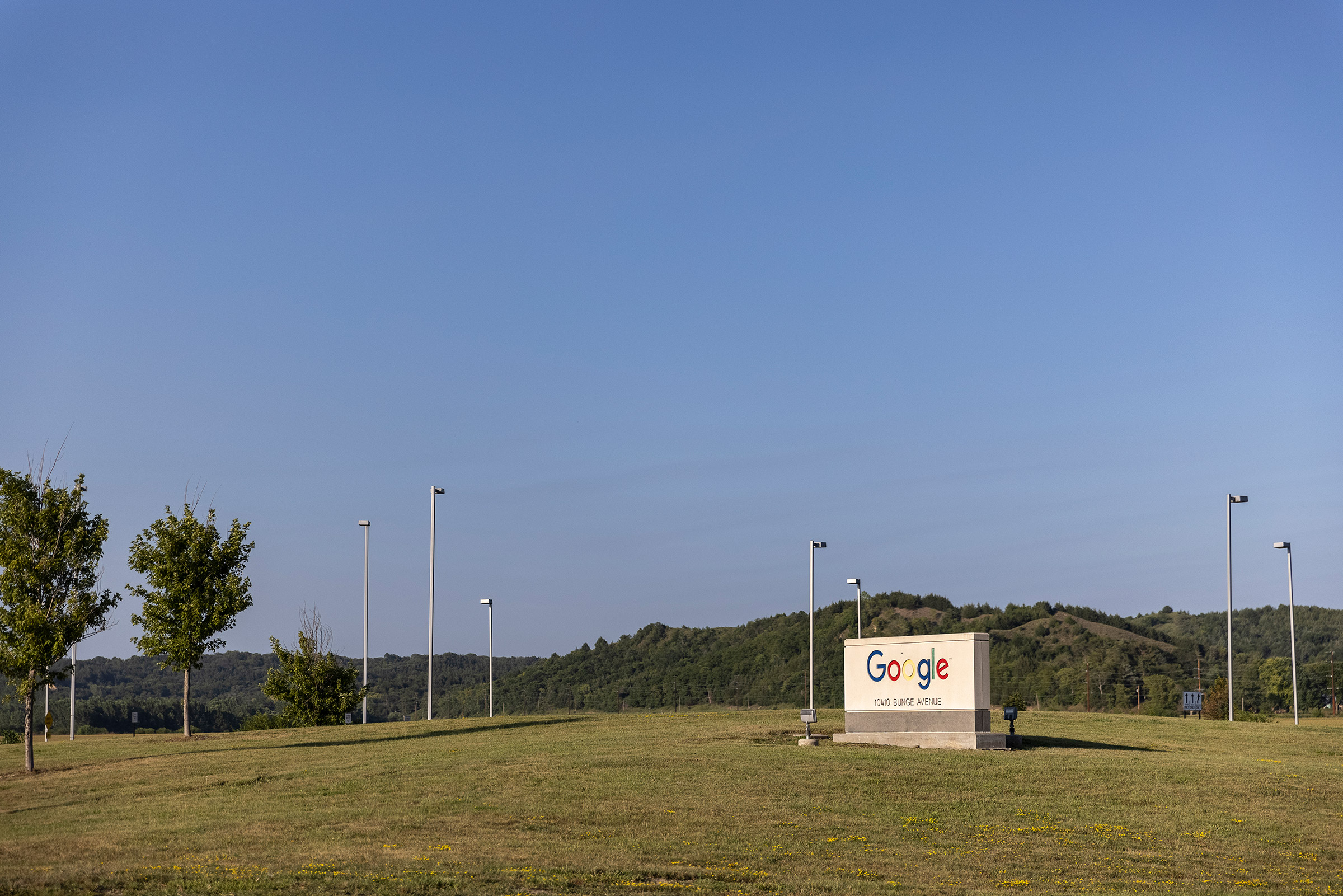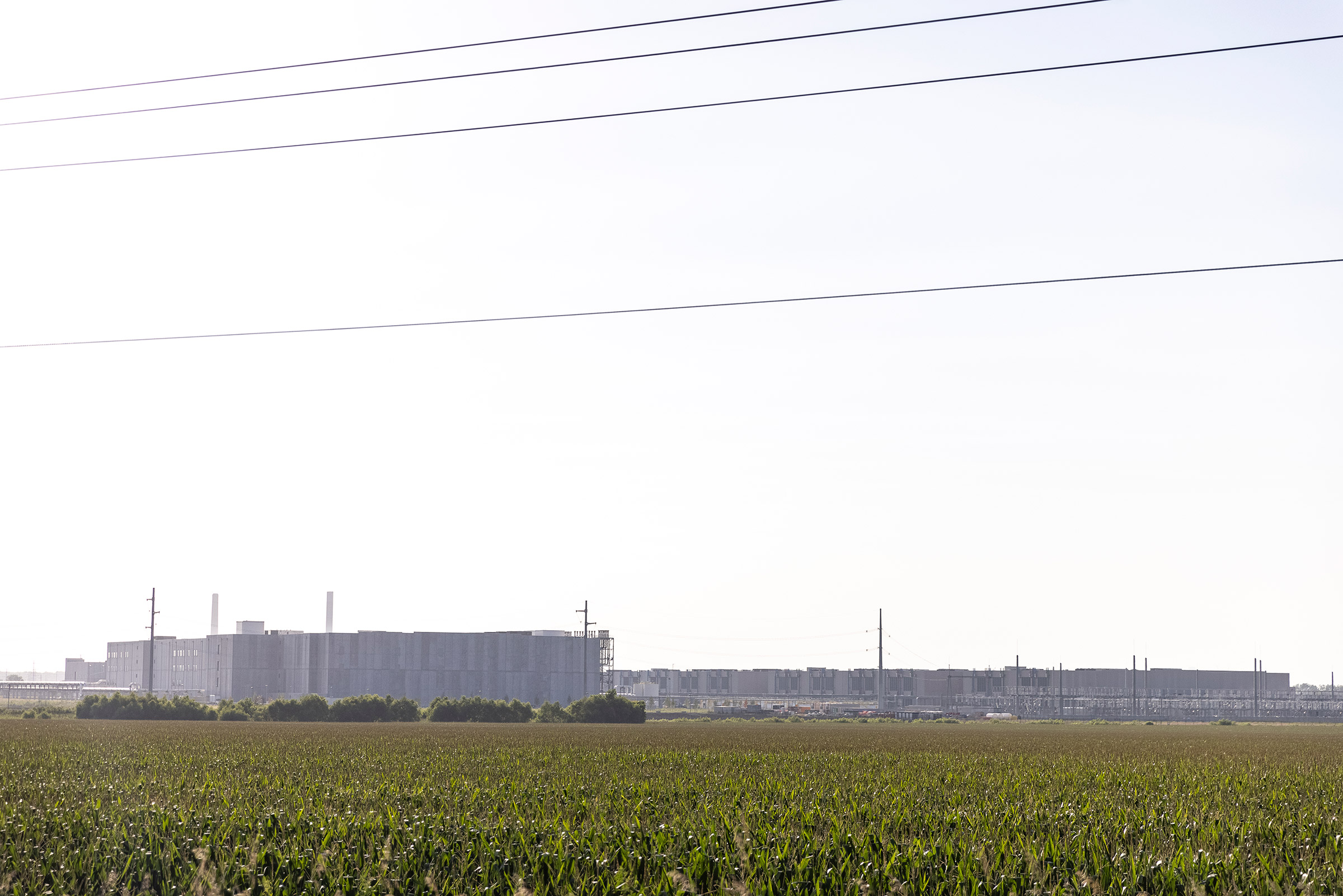
These are independent reviews of the products mentioned, but TIME receives a commission when purchases are made through affiliate links at no additional cost to the purchaser.
Ned McNally is a tech nerd who fixes computers for family and friends. So he couldn’t believe his luck when a recruiter this year asked if he’d leave his job at an electrical-supply warehouse to work at a massive Google server farm in Council Bluffs, Iowa, across the river from where he lives in Omaha.
McNally, who had been watching the Google facility grow since it opened in 2007, eagerly accepted. As more data and applications were stored on the cloud, the company kept adding buildings to house servers and other equipment to keep up with demand, expanding in 2013 and again in 2019. He’d be earning the same wage that he’d made at the warehouse, but McNally was excited to join one of America’s most valuable and innovative companies.

Even if they do a perfect job and do everything right, they're going to get laid off soon.
But the company that recruited McNally was not Google; it was Modis Engineering, a contractor that employs thousands of the people at Google facilities across the country. And the job was not permanent. Like almost all Modis workers, McNally was hired on a three-month contract renewable for only two years, after which he’d be unemployed and ineligible to reapply to Modis for six months. That didn’t deter McNally, who hoped that if he worked hard enough and proved himself a capable employee, Google would hire him permanently. Only after accepting the Modis job, he says, did he learn that Google hadn’t hired anyone as a full-time Google employee at that location in more than two years.
“It’s demoralizing for most people,” says McNally, 27, who has a partially completed computer-science degree. “Even if they do a perfect job and do everything right, they’re going to get laid off soon.”
Read more: Many Companies Won’t Survive the Pandemic. Amazon Will Emerge Stronger Than Ever
Google is one of the most valuable companies in America, worth nearly $2 trillion dollars—roughly double what it was worth in 2019. On Tuesday it reported record profits of $18.5 billion; Apple said it made $21.7 billion in the quarter and Microsoft earned $16.5 billion, up 47% from the same period last year. But few big tech companies that are building and hiring across America bring that wealth with them when they set up in new communities. Instead, they hire armies of low-paid contractors, many of whom are not guaranteed a job from one month to the next; some of the contracting companies have a history of alleged mistreatment of workers. Nor do local governments share in the companies’ wealth; instead, the tech giants negotiate deals—the details protected by non-disclosure agreements—that exempt them from paying taxes that would fund schools, roads and fire departments.
More from TIME
Tech may dominate the economy, but as these companies grow while others struggle to recover from pandemic shutdowns, they’re wielding their power in ways detrimental to the communities welcoming them. “Firms utilizing their economic wherewithal as a potential carrot or stick—that’s a powerful tool,” says Davin Raiha, an economics professor at Notre Dame who studies how firms exert political influence.

Why Big Tech Keeps Getting Bigger
Every time you send an email or store a photo or save something on the cloud, it’s likely you’re depending on a data center like the one in Council Bluffs. Such centers house the computer equipment that keeps the Internet running. And with more products like refrigerators and cars becoming wi-fi-enabled, demand for data centers continues to grow. Even as malls empty and more and more businesses go online, one type of building remains a sure bet to keep popping up across the U.S.: data centers.
Globally, by the end of 2020, there were nearly 600 “hyperscale” data centers, where a single company runs thousands of servers and rents out cloud space to customers. That’s more than double the number from 2015. Amazon, Google and Microsoft account for more than half of those hyperscale centers, making data centers one more field dominated by America’s richest and biggest companies. President Biden recently took aim at these behemoths, releasing an executive order on July 9 aimed at promoting competition in the U.S. economy.
But as more of our lives are spent online, big tech gets bigger. Google in March said it was “investing in America” with a plan to spend $7 billion across 19 states to build more data centers and offices. Microsoft said in April that it plans to build 50 to 100 data centers each year for the foreseeable future. Amazon recently got approval to build 1.75 million square feet of data-center space in Northern Virginia, beyond the 50 data centers it already operates there. Facebook said this year it would spend billions to expand data centers in Iowa, Georgia and Utah; in March it said it was adding an 11th building to its largest data-center facility in rural Prineville, Ore.

“We were just so hungry—this was our shot,” says Eric Klann, the city engineer of Prineville, where Facebook opened a massive data-center complex in a region once dependent on timber. The Crook County unemployment rate was nearing 20% when Klann was going into negotiations with Facebook in 2009. “I saw that, and said, ‘Let’s roll the dice. We’ve got to do something,’” he said.
Facebook has spent more than $2 billion expanding its operations in Prineville, but because of the tax incentives it negotiated with local officials, the company paid a total of just $119,403.42 in taxes to Crook County last year, according to the County Assessor’s list of top taxpayers. That’s less than half the taxes paid by Brasada Ranch, a local resort. And according to the Oregon Bureau of Labor and Industries, the data center has been the subject of numerous labor complaints. Its security contractor in Prineville, G4S Secure Solutions, last year agreed to pay $595,000 to settle five racial discrimination cases; the workers had complained that supervisors referred to them as the “Mexican mafia” and reassigned workers with Hispanic last names from the day shift to the night shift, according to their complaints with the Bureau of Labor and Industries.(G4S said in a statement that it resolved the matters with the Bureau of Labor and Industries and that it “continues to deny any liability.” It added that “none of the complainants experienced any adverse employment actions.”)
This is the underside of an economy dominated by big tech companies, whose size guarantees them leverage. The value of the five biggest (Amazon, Facebook, Alphabet, Apple and Microsoft) has soared during the pandemic, accelerating in recent days after strong earnings reports; in total, they are currently worth nearly $9 trillion, nearly 25% of the value of the S&P 500. They are among the few deep-pocketed businesses still spending billions to build new facilities across America—which means they’re able to treat workers and policymakers in ways few other companies dare.
A Different Kind of Tech Workplace
This is not the tech workplace of free laundry and foosball—certainly not if you believe the complaints from workers. In Oregon, G4S Secure Solutions has been the subject of more than two dozen labor complaints since 2016, according to data obtained by TIME from Oregon’s Bureau of Labor and Industries through a Freedom of Information Act. Many of these complaints revolve around allegations that the company is not paying people on time. The sheer number is telling, even if some of them were not substantiated.
“This looks like the third complaint on this issue within 12 months (apart from additional sick leave issues),” a compliance manager at the state Bureau of Labor and Industries wrote in 2016 to colleagues about G4S. “Let’s go ahead and set this up for investigation, please.” Workers then filed claims against G4S alleging unpaid wages in 2017, 2018 and 2019.
A woman who worked as a security guard for G4S at Amazon data centers in Oregon filed a complaint in 2018 alleging a history of sexual harassment from a supervisor. Another G4S contractor in Prineville filed a complaint in 2018 saying he was fired for “insubordination” after taking leave when his wife died; the computer system showed him as having skipped work, he alleged, even though he’d been informed the leave was approved. A G4S worker who was placed at a Google data center in North Carolina filed a lawsuit in 2017, alleging that the company required her to do work before and after her shift but did not pay her for it.
Read more: Hourly Workers Are Demanding Better Pay and Benefits—and Getting Them
Some workers end up bouncing around between different contractors at data centers, trying to find a good job. Eric Sellers, 41, got a job with G4S at Google’s data center in Iowa in 2015. From the start, “It was a horrible experience,” he says. Sellers says supervisors bullied and mocked him for not knowing his way around the facility. He got to know Google employees as they went through his metal detector, and after four years, he found a different job at the same data center—this time with Modis, the company that hired McNally in Council Bluffs. Sellers loves the type of work he does for Modis, and says he’s finally found a job he wants to do for the rest of his career, but he hit his two-year limit in early July. He wants to get hired by Google, but he says the company has outsourced more, rather than fewer, jobs to Modis during the time he’s been there. Sellers and other Modis employees told me they do the exact same work as Google employees, contractors are only distinguishable because their badges are a different color.
The short-term nature of the Modis jobs has created other problems too. “People were hurting their back and shoulders and not reporting it because most of the people doing this kind of work are contractors; they are very vulnerable to losing their job if they complain,” says Shannon Wait, a former Modis contractor at Google’s data center in Berkeley County, South Carolina. Wait filed a complaint with the National Labor Relations Board in February, alleging she was suspended after talking about her contractor status on Facebook. (As a response to Wait’s complaint, Google reinstated her and agreed to post a notice informing workers that they have the right to discuss wages with other employees, and that they have the right to form a union.)
The drive in these big tech companies is to get the workers off their books and have someone managing, hiring and firing them.
But, as Sellers says, tech companies are indeed moving many positions to contract jobs, says Jenna Burrell, a professor at the University of California, Berkeley, who studied the data centers in Oregon. “There’s a tension around labor,” she says. “The drive in these big tech companies is to get the workers off their books and have someone managing, hiring and firing them.”
There were 373,300 workers in data processing, hosting, and related services in June, up 52% from a decade ago, according to the Bureau of Labor Statistics. This does not count security contractors, janitorial staff, or food services providers at the data centers.

Facebook said in a statement to TIME that it does not comment on legal matters related to its vendors, but added that Facebook “is committed to racial equity and to providing a safe and open working environment for everyone.” Google said in a statement that it was “proud that our data centers spur economic development in communities and create new career opportunities for thousands of people.” It contracts with businesses around the world, it says, “where we don’t have appropriate in-house expertise or resources,” and that the vendors who work for those businesses “account for the overwhelming majority of our extended workforce.” G4S attempts to pay all of its employees correctly, but that given the size of its business, “payroll errors can inadvertently occur,” said Sabrina Rios, vice president of communications, in a statement. “We work with those employees to quickly correct their wages and provide retroactive pay.”
Modis’ parent company, Adecco, declined to comment.
Big Tech—and Big Tax Breaks
If tech companies take a hands-off approach to supervising data-center workers, they’re extremely aggressive when it comes to extracting concessions from elected officials.
In November, officials in Berkeley County quietly approved amendments to an existing tax incentive agreement that allowed Google to spend $500 million to expand its data center there, despite local concerns about the amount of groundwater the facility consumes. There were no press releases heralding the agreement—probably because Google will be paying lower taxes starting in 2022, even though the expansion will significantly increase the value of its property.
The company had persuaded Berkeley County to give it special tax credits in 2018, threatening to go elsewhere without them, says a source who was not authorized to speak publicly on the deal because of a nondisclosure agreement. The deal included a 100% credit for personal property investment, according to the document TIME obtained through a Freedom of Information Act request. The county didn’t worry about the credit because Google categorized very little equipment as personal property, the source said. At the time, Google was paying Berkeley County about $14.5 million a year, which helped fund schools and police.
But in the fall of 2020, Google told the county it would be reclassifying much of its property as “personal,” cutting its annual tax payment to the county to $6 million. Google also said the county owed it money.
The county had little room to push back; its tax revenues would drop if Google left the area. (Google says it assessed its properties after the Tax Cut and Jobs Act of 2017 and found there had been a “misclassification of property” in Berkeley County that would have required the county to give the company a “significant refund.” It agreed to forgo the refund and keep taxes stable for two years.)
So officials signed an agreement that has Google paying around $11 million a year starting in 2022, and then paying less each year after that. Council members told me that they had no choice but to accept the terms.
“We didn’t want to throw the baby out with the bathwater, regardless of how dirty it might be,” says Caldwell Pinckney, a Berkeley County councilman.
I sometimes wonder if they're preying on desperation, going to places that are struggling.
Berkeley County’s situation isn’t unique. In fact, states and counties are tripping over one another to offer multimillion dollar incentives to tech giants. In an economy where manufacturing and mining jobs have been replaced by low-paid service jobs, local officials can have a big win by attracting a marquee name like Google.
“I’ve spent way too much of my life watching city councils say, ‘We need a big tech company to show that we’re future-focused,’” says Sebastian Moss, the editor of Data Center Dynamics, which tracks the industry. Towns will give away tax breaks worth hundreds of millions of dollars, his reporting has found, and then express gratitude toward tech companies that have donated a few thousand computers—worth a fraction of the tax breaks—to their cash-strapped school systems. “I sometimes wonder if they’re preying on desperation, going to places that are struggling.”
Communities give up more than tax breaks when they welcome tech companies. Data centers use huge amounts of water to cool computer equipment, yet they’re being built in the drought-stricken American West. Google’s Berkeley County data center is on the lush Carolina coast, but the company has upset local utilities who say it is using groundwater that should be used for drinking. And though tech companies pay more than many other jobs in some economically depressed areas, the jobs are often temporary and come without benefits, and they’re nowhere close to what tech employees make in Silicon Valley.
Still, Connecticut and Michigan recently passed bills waiving certain taxes for data centers. Virginia passed a bill in March that sweetened the tax breaks for companies setting up data centers in distressed communities; they now need to invest only $70 million, down from $150 million, and create 10 jobs, down from 25. A group of counties in Southwest Virginia agreed to establish the state’s lowest tax rate, $0.24 per $100 of assessed value, to lure more data centers, even though an analysis found this would create only about 59 permanent jobs.
By 2019, Facebook, Google, Microsoft and Apple had received $130 million in tax incentives for data centers in Iowa, according to the Des Moines Register. And an agreement between Amazon and Umatilla County, Oregon, exempts Amazon from paying property taxes for 15 years, as long as it creates at least 10 full-time jobs on the site..
“When you’re giving one of the biggest global companies tax breaks, you’re putting the burden back on our small businesses and homeowners,” says Ric Sherman, board president of Umatilla County Fire District. He says the money the county is losing to tax incentives could have gone to replace equipment and add critical staff. “We’re losing millions of dollars over 15 years of exemptions.”

There are a few places where local officials and workers are starting to realize that tech doesn’t always bring a good deal. But most of these places are not in the United States. Singapore halted data center construction in 2018, according to Moss, and there’s a moratorium on new data-center development in the Dutch province of Flevoland, and Amsterdam recently began enforcing strict criteria for efficiency and sustainability in its centers. China has many restrictions on data centers governing how energy-efficient they must be. (Many new data centers are becoming more energy-efficient, but since tech companies pay for the power they use, there’s little incentive for local governments to speed up that process.)
But efforts to slow tech expansion in the U.S. have not been as successful. Although Michigan lawmakers objected to huge tax incentives given to a data center there, the legislature narrowly approved more tax breaks last year. A vocal vice mayor in drought-stricken Mesa, Ariz., could not persuade the local council to vote down an $800 million data-center development out of concern for its water usage. She was the sole “no” vote.
In many places where tech giants are setting up shop as other businesses shut down, locals don’t have many options. Eric Sellers, the former G4S and Modis worker in Iowa, says he wants to keep working at the Google data center, even though his Modis time limit is up. There are limited opportunities to do the work he enjoys in Council Bluffs, he says—he had a good job at a Frito-Lay plant, but PepsiCo closed it more than a decade ago. Then he worked in printing, another dying industry. But with Google, he’s found the type of work he loves to do, at a company that is thriving.
He knows the data center isn’t going anywhere, so he applied for a job with two other contractors there: Johnson Controls, and Insight Global. Neither worked out, so he’s planning on doing what other Modis workers do: apply for unemployment, wait six months, and then apply once again for a short-term job at the data center. “My plan is to keep working there till I’m 80 years old,” he says, “whether they hire me or not.”
More Must-Reads From TIME
- The 100 Most Influential People of 2024
- The Revolution of Yulia Navalnaya
- 6 Compliments That Land Every Time
- What's the Deal With the Bitcoin Halving?
- If You're Dating Right Now , You're Brave: Column
- The AI That Could Heal a Divided Internet
- Fallout Is a Brilliant Model for the Future of Video Game Adaptations
- Want Weekly Recs on What to Watch, Read, and More? Sign Up for Worth Your Time
Contact us at letters@time.com